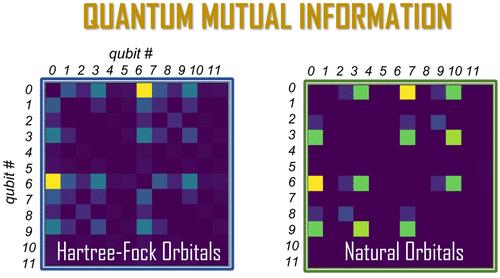当前位置:
X-MOL 学术
›
J. Chem. Theory Comput.
›
论文详情
Our official English website, www.x-mol.net, welcomes your feedback! (Note: you will need to create a separate account there.)
Natural Orbitals and Sparsity of Quantum Mutual Information
Journal of Chemical Theory and Computation ( IF 5.5 ) Pub Date : 2024-04-24 , DOI: 10.1021/acs.jctc.3c01325 Leonardo Ratini 1, 2 , Chiara Capecci 2 , Leonardo Guidoni 1
Journal of Chemical Theory and Computation ( IF 5.5 ) Pub Date : 2024-04-24 , DOI: 10.1021/acs.jctc.3c01325 Leonardo Ratini 1, 2 , Chiara Capecci 2 , Leonardo Guidoni 1
Affiliation

|
Natural orbitals, defined in electronic structure and quantum chemistry as the molecular orbitals diagonalizing the one-particle reduced density matrix of the ground state, have been conjectured for decades to be the perfect reference orbitals to describe electron correlation. In the present work we applied the Wave function-Adapted Hamiltonian Through Orbital Rotation (WAHTOR) method to study correlated empirical ansätze for quantum computing. In all representative molecules considered, we show that the converged orbitals are coinciding with natural orbitals. Interestingly, the resulting quantum mutual information matrix built on such orbitals is also maximally sparse, providing a clear picture that such orbital choice is indeed able to provide the optimal basis to describe electron correlation. The correlation is therefore encoded in a smaller number of qubit pairs contributing to the quantum mutual information matrix.
中文翻译:

自然轨道和量子互信息的稀疏性
自然轨道在电子结构和量子化学中定义为对角化基态单粒子约简密度矩阵的分子轨道,几十年来一直被认为是描述电子相关性的完美参考轨道。在目前的工作中,我们应用波函数自适应哈密顿通过轨道旋转(WAHTOR)方法来研究量子计算的相关经验分析。在考虑的所有代表性分子中,我们表明收敛轨道与自然轨道一致。有趣的是,建立在此类轨道上的量子互信息矩阵也是最大程度稀疏的,这清楚地表明这种轨道选择确实能够提供描述电子相关性的最佳基础。因此,相关性被编码在较少数量的量子位对中,从而形成量子互信息矩阵。
更新日期:2024-04-24
中文翻译:

自然轨道和量子互信息的稀疏性
自然轨道在电子结构和量子化学中定义为对角化基态单粒子约简密度矩阵的分子轨道,几十年来一直被认为是描述电子相关性的完美参考轨道。在目前的工作中,我们应用波函数自适应哈密顿通过轨道旋转(WAHTOR)方法来研究量子计算的相关经验分析。在考虑的所有代表性分子中,我们表明收敛轨道与自然轨道一致。有趣的是,建立在此类轨道上的量子互信息矩阵也是最大程度稀疏的,这清楚地表明这种轨道选择确实能够提供描述电子相关性的最佳基础。因此,相关性被编码在较少数量的量子位对中,从而形成量子互信息矩阵。



























 京公网安备 11010802027423号
京公网安备 11010802027423号